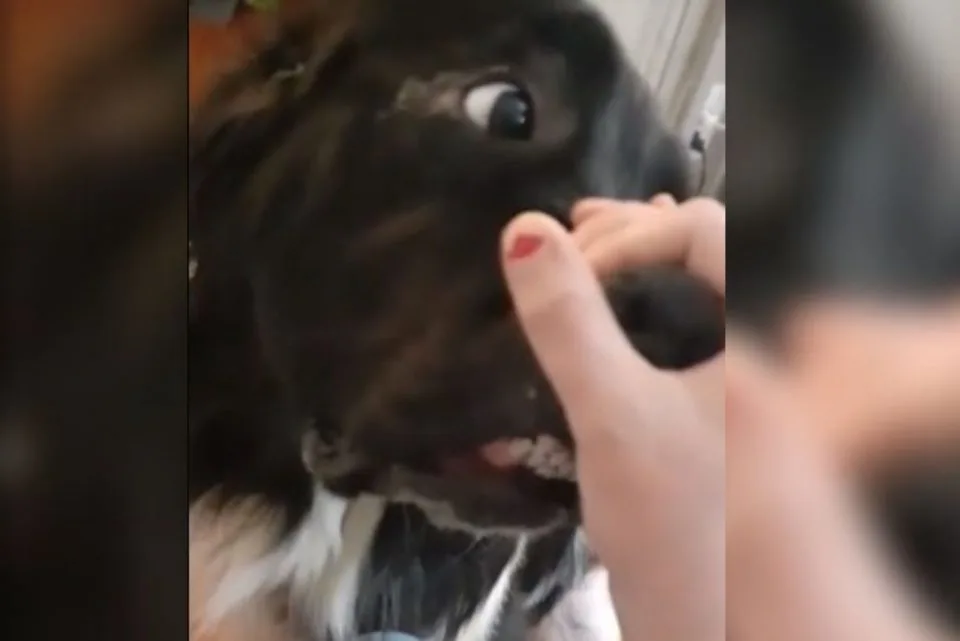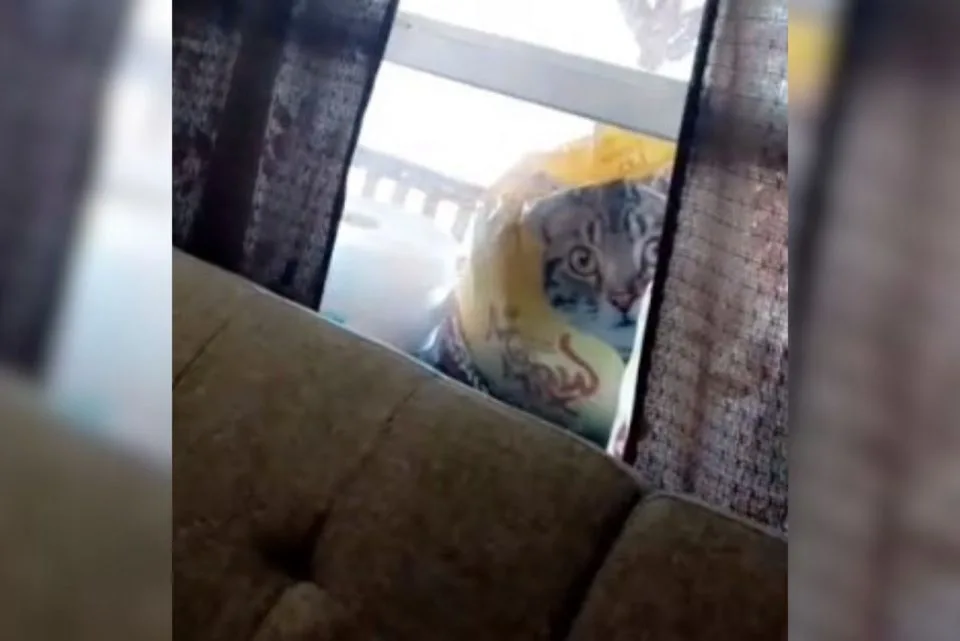Dogs communicate with us by barking.
I know I know… they would tell us what’s wrong if only they could. But, until science progresses and we become able to understand doggish, we have to listen to those late-night barks.
And, it ain’t always so pleasant.
Christina Bingman’s dog was driving her crazy that night. Alexa was going on and on all night long. When a dog wakes you up at 2 in the morning, you’re scared, worried, and a bit restless.
Because… there’s something that made him turn up the volume and bark that loud.
Were there some intruders?
Did Alexa, Christina’s dog, see someone at the door?
Or, was that fox back again, trying to break into the chicken coop?
It Was A Long, Sleepless Night

The first bark was kinda ignored.
Then came another one… and another one…
By this point, Christina’s eyes were wide open.
What is that? Why is Alexa barking in the middle of the night?
As she listened carefully to her dog’s tone, Christina realized it was the bark of warning.
Alexa only barks like that when she sees someone she doesn’t know.
Christina ran outside to check on her chickens in case someone came to steal them. However, the entire yard, including the chicken coop, was peaceful.
No one was there. There weren’t even signs that someone visited the family late at night and left.
So, Christina did the only thing that seemed logical to her: she went back inside, locked the door, and went to sleep.
But, she couldn’t sleep at all that night.
Alexa kept going on as if someone was still there. She made her mom get up so many times that night that she lost count.
The next morning was a pain. After not sleeping well the night before, Christina got up and started wondering what all that barking was about. Alexa seemed exhausted from her late-night serenades. Yeah, you and me both, sister!
Just when they thought they would never figure out what made the usually sweet dog so restless, the youngest kid in the family found the reason behind all that drama.
It was a bag of cat food, and not just any kind.

A bag with a huge cat pictured on it was left outside the window, so it appeared as if the said cat was watching Alexa the entire night!
“I discovered that she was actually barking at the bag of cat food once the family had woken up for the day,” Bingman said. “My youngest told me to look at the window and laughed at how real the cat on the bag looked, and how giant it was.
Then it clicked for me what Alexa had been trying to tell me. There was a giant cat staring in the window at her all night.”
The sweet Newfoundland girl just wanted to protect her family from the big, ugly, stranger kitty-cat!
The family said it was hilarious, but Alexa has something she wants to share with all of us:
Sure… Now you’re laughing! If it wasn’t for me, you’d be attacked by that evil kitty cat. You were all asleep. I don’t wanna imagine what would happen to y’all if she got it.
Don’t be deceived. That cat was alive last night, I’m telling ya!
I gotta rest today because she’s striking back tonight.
This time, I’m prepared for the battle.
Well, Alexa, that was mighty brave of you, but you should know that mommy moved the bag of kitty food away from the window, so you won’t be bothered by it anymore.
Still, keep an eye out for other intruders. You’re such a good guardian!
If you’ve ever wondered why your furry friend can’t snack on grapes like you do, it’s not just a matter of preference. Dogs and grapes are a combination best kept apart. Understanding the reasons behind this restriction can help you ensure your pup stays safe and healthy. The mystery behind why dogs and grapes don’t mix might surprise you, shedding light on the importance of being mindful of what your canine companion consumes. So, next time you reach for that bowl of grapes, you’ll know exactly why it’s a big no-no for your four-legged buddy.
The Toxic Nature of Grapes to Dogs
What Happens in a Dog’s Body
When a dog ingests grapes or raisins, it can lead to severe toxicity. The exact substance in grapes that causes this reaction is still unknown. However, even small amounts of grapes can trigger harmful effects in your furry friend.
Symptoms of Grape Toxicity in Dogs
If your dog consumes grapes, watch out for signs of grape toxicity. Symptoms may include vomiting, diarrhea, lethargy, and abdominal pain. In severe cases, grape ingestion can lead to kidney failure, which can be fatal if not addressed promptly.
The Science Behind Grape Toxicity
The Mystery of the Toxic Compound
Grapes can be extremely harmful to dogs, but the exact toxic substance responsible remains unknown. Scientists are still uncertain about what makes grapes toxic to dogs. This mystery complicates the treatment of grape toxicity in canines and makes it challenging to develop specific antidotes or treatments.
Research on Grape Poisoning
Researchers are actively studying grape poisoning in dogs to uncover the specific compound or compounds responsible for the toxic effects. Understanding the scientific mechanisms behind grape toxicity can pave the way for better treatment strategies and preventive measures. Ongoing research aims to shed light on how these fruits cause harm to our furry friends.
Risk Factors and Variability of Toxicity
Size and Breed Sensitivities
When it comes to grape toxicity in dogs, size and breed play a significant role in how a dog may react to consuming grapes. Smaller dogs are generally more vulnerable to grape toxicity due to their lower body weight, which makes even small amounts of grapes potentially harmful. Additionally, certain breeds might have higher sensitivities to grape toxicity compared to others. It’s essential to be aware of these factors, especially if you have a small breed dog, to prevent any accidental grape ingestion.
Quantity: How Much is Too Much?
Determining the exact quantity of grapes that can be toxic to dogs is challenging as it varies from dog to dog. However, it’s best to adopt a strict no-grapes policy for your furry friend. Even a small amount of grapes can lead to serious health issues in dogs, including kidney failure. To keep your dog safe, it’s crucial to avoid giving them grapes in any quantity. Remember, prevention is key when it comes to grape toxicity in dogs.
Managing Grape Ingestion in Dogs
Immediate Actions for Dog Owners
If your dog has ingested grapes or you suspect they have, here are some immediate actions you should take:
- Induce Vomiting: Encourage your dog to vomit by giving them hydrogen peroxide. Contact your vet before inducing vomiting, especially if your dog is showing symptoms.
- Visit the Vet: Take your dog to the vet immediately after grape ingestion, even if they are not showing symptoms. The vet can assess the situation and recommend further treatment.
- Monitor Symptoms: Keep a close eye on your dog for any signs of grape toxicity, such as vomiting, diarrhea, or lethargy. Immediate action is crucial in such cases.
Veterinary Treatments and Interventions
When it comes to veterinary treatments for grape ingestion in dogs, here’s what you can expect:
- Induced Vomiting: In severe cases, the vet may need to induce vomiting to remove the grapes from your dog’s system.
- Fluid Therapy: To prevent dehydration and support kidney function, your dog may receive fluid therapy.
- Monitoring: Your vet will closely monitor your dog’s condition, including kidney function tests, to ensure they are responding well to treatment.
Remember, swift action and veterinary care are critical in managing grape ingestion in dogs to prevent serious health complications.
Preventing Grape and Raisin Exposure
Safe Alternatives to Grapes and Raisins
When it comes to your dog, it’s vital to steer clear of grapes and raisins altogether. Look for safe alternatives to these potentially harmful fruits. Opt for dog-friendly snacks like carrots, blueberries, or sliced apples as treats instead. Always double-check before sharing any human food with your furry friend to ensure their safety.
Educating Others About the Dangers
Spread awareness about the dangers of grapes and raisins to ensure the well-being of all dogs. Educate your family, friends, and anyone who interacts with your pet about the toxicity of these fruits. Remind them never to feed grapes or raisins to dogs, no matter how much they beg for a bite. Prevention is key when it comes to keeping our beloved four-legged companions safe and healthy.
Conclusion
So, remember, grapes can be extremely harmful to your furry friend. Even a small amount can lead to serious health issues like vomiting, diarrhea, and kidney failure. It’s crucial to act fast if your dog ingests grapes to prevent any fatal outcomes. The risk factors are varied, but smaller dogs and certain breeds are more susceptible. To play it safe, it’s best to steer clear of grapes altogether and opt for safe alternatives like carrots or blueberries. Educating yourself and others about the dangers of grapes is key to keeping your dog healthy and happy. Stay vigilant, and your pup will thank you for it.
Frequently Asked Questions
Can grapes really be toxic to dogs?
Yes, grapes can be highly toxic to dogs, leading to symptoms like vomiting, diarrhea, and potentially fatal kidney failure.
Are certain dogs more vulnerable to grape toxicity?
Yes, smaller dogs and certain breeds are more susceptible to grape toxicity due to their size and metabolism.
How many grapes can be toxic to a dog?
The exact quantity of grapes that can be toxic to dogs varies, so it’s best to avoid feeding any grapes to your pet.
What should I do if my dog eats grapes?
If your dog ingests grapes, induce vomiting immediately, seek veterinary help, and closely monitor for symptoms of toxicity.
What are the recommended treatments for grape toxicity in dogs?
Veterinary treatments like induced vomiting, fluid therapy, and close monitoring are crucial to prevent severe health complications.
Are there safe alternatives to grapes for dogs?
Yes, opt for safe alternatives like carrots, blueberries, or sliced apples instead of grapes to keep your dog healthy and happy.
[no_toc]

Hey there, I’m Janet Brooks, a dog-loving student from California. I’m all about helping pups in need, especially those without homes. Me and my awesome friends work together to give shelter and love to stray dogs. Oh, and I also write blogs about dogs to share helpful info.